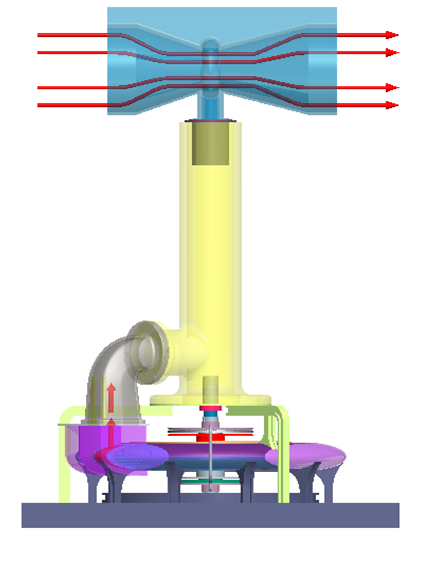RVCR Wind Power Generators (RWPG)
A new dimension in tapping wind energy using ground level positive displacement wind motors .

Project
Making VCR viable
- in Wind Motor Generators
- The project arm of GYATK for RVCR Wind Motor technology and pilot product development
Every individual application project plan is made, and the generic high level (non-confidential) information is made available under a subdomain of KGYAT.
The various heads are discussed below.
The title -
Commercializing RVCR technology based Wind power generator applications.
Wind energy seems abundant
– yet why is its share of renewable energy market
When it comes to means of tapping wind energy for power generation, the global industry is dependent on the existing 3 bade wind turbine technology. The turbines designs are saturating at peak efficiencies and the only way to improve is to build bigger ones
Our solution is based on RVCR (Roto-dynamic variable Compression Ratio) mechanism in energy conversion. It is globally patented concept with IP rights is owned by ‘GYATK RVCR Apparatus P. Ltd’ (GYATK). With extensive R&D on the RVCR principle, GYATK has developed the knowhow to develop customized RVCR wind motors systems.
Our RVCR wind motors are 1st of its kind working on a positive displacement mechanism. The project is aimed at customizing the RVCR Know how creating newer markets of highly efficient ‘City-based’; ‘Off and On-shore’ wind power units.
RVCR wind motors enables tapping of rough weather winds (when turbines collapse) thus initiating the advent of ‘Climate energy power’ systems. RVCR affects multi-fold increase in ‘Energy Capture Factor’, cuts installation and operational costs. The project is selected by Global entrepreneurship program of the UK dept of international trade to base its business operations in UK.
Background
Background
Compared to conventional wind turbines RVCR mechanism-based wind power generator motors are better, efficient machines. The Conventional wind turbines are driven by lift, achieved by aerofoiled profile of turbine blades. The axial flow wind turbines are rotary machines converting the Kinetic Energy of Wind into Power. RVCR uses pressure differential between high wind velocity zone and ground level stagnant air conditions.
At higher altitudes, wind flows unrestricted in a laminar flow whereas, at near earth surface, wind speed is lower for no-slip condition and disturbances like buildings, trees etc. As the distance from earth surface increases, resistance to air flow decreases and it results in higher wind speeds. The ground creates friction and turbulence which gradually tapers off at greater heights.
Conventional wind turbines are usually located at places; far away from city, where there is enough room to install them and no danger to populace. Preferred locations are sufficiently windy and have largely constant winds like exposed high areas, hills, or small mountains or coastal/Off-shore areas. Main drawback of these conventional wind turbines is the location constraint, as these systems should be installed away from city or areas of electric power demand. The structure of these wind turbines is quite bulky. It is always difficult to transport components (like blades) of these wind turbines to the specified wind sites, special roads has to be constructed. During the operation, turbine should orient itself against the direction of wind flow. Initial cost of these turbines is quite high, consequently increasing the overall cost of the wind energy. Yawing, furling and stalling demands special drives, this results in complicated structure. Wind turbines are not positive displacement machines, so the flow efficiency is lower.
RVCR wind motor utilizes pressure differential phenomenon at different altitudes (Bernoulli’s principle). As the wind blows over the upper region, according to Bernoulli’s principle, pressure is lowered with increased wind speed; hence the air from the lower region, which is comparatively at higher pressure, when provided with suitable flow path flows rapidly towards low-pressure zone in the upper region. This suction force is utilized to generate power by RVCR wind motors. Air flow from lower to upper region is channeled through stacks. So, the more the height of a building, the more will be the pressure differential and consequently, more power will be generated.
RVCR wind motors can be installed in city itself within the building, so unlike conventional wind turbines, the cost of searching of wind sites, transportation of the components to such remote locations can be saved. Compared to bulky structures of wind turbines, RVCR wind motors are quite compact, easy to handle, and manufacturing cost is also lower. This in turn leads to lower initial investment. While in operation, RVCR wind motor is independent of wind flow direction, so the power is continuously generated even if the wind flow direction is changed. Depending upon the wind speed, the angle between vanes can be set so as to get continuous power supply (An advantage of VCR component). It is a positive displacement machine which leads to higher flow efficiencies.

Wind & Water Power Generators Applications
- City Based Wind Power Embedded Generators
- Outdoor high capacity Wind Power Generators
- Portable Wind Power Generators

Contact Us
Phone Number
+91 74030 08844
Email Account
info@gyatk.com
Location
GYATK RVCR Apparatus Pvt Ltd, India,
KGYAT Wind Power Ltd, United Kingdom
